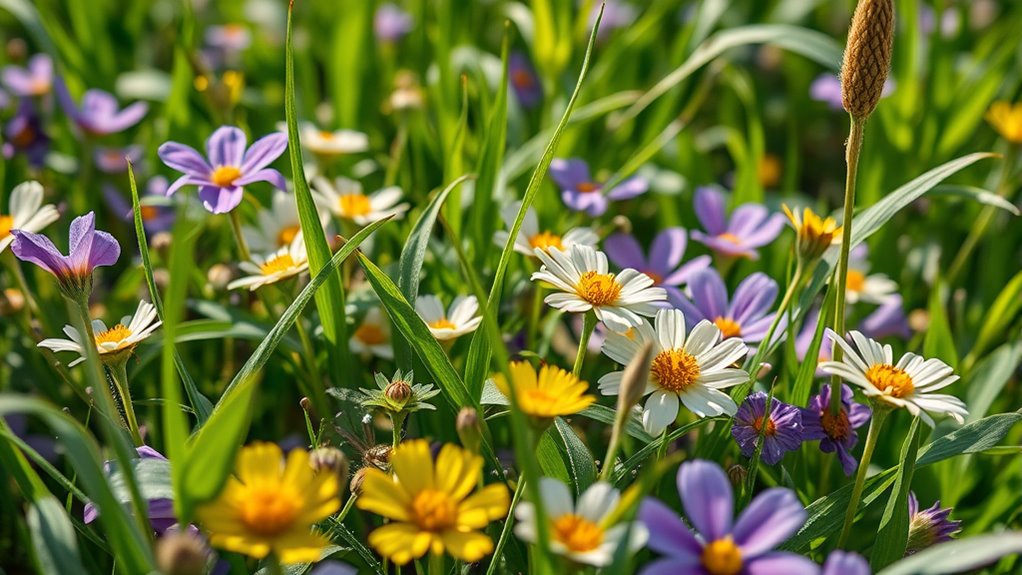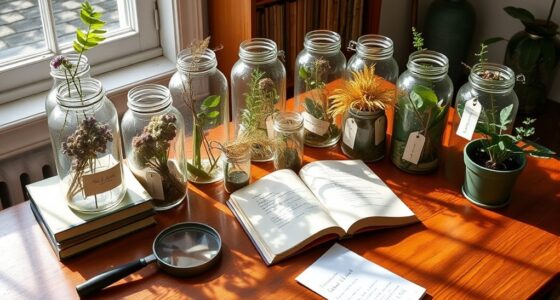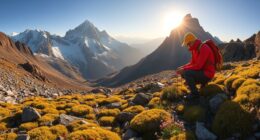To improve your plant ID photos in the field, focus on using a camera with macro capabilities and a sturdy tripod for stability. Pay attention to natural lighting—shoot during golden hours and avoid harsh midday sun. Capture multiple angles and close-up details like leaf veins or petal textures, keeping your focus sharp. Manage environmental challenges with equipment protection and weather awareness. Keep practicing these techniques, and you’ll discover more tips to boost your plant photography skills.
Key Takeaways
- Use macro lenses and focus lock techniques to capture detailed close-ups of leaves, flowers, and textures vital for accurate identification.
- Photograph from multiple angles and perspectives to reveal key features like vein patterns, petal structures, and surface textures.
- Utilize natural diffused light during golden hours and avoid harsh midday sun to enhance color accuracy and detail visibility.
- Ensure proper equipment stabilization with tripods and secure gear to prevent blurring, especially in uneven field conditions.
- Incorporate background contrast and clean framing by paying attention to composition rules like the rule of thirds and symmetry.
Choosing the Right Equipment for Field Photography
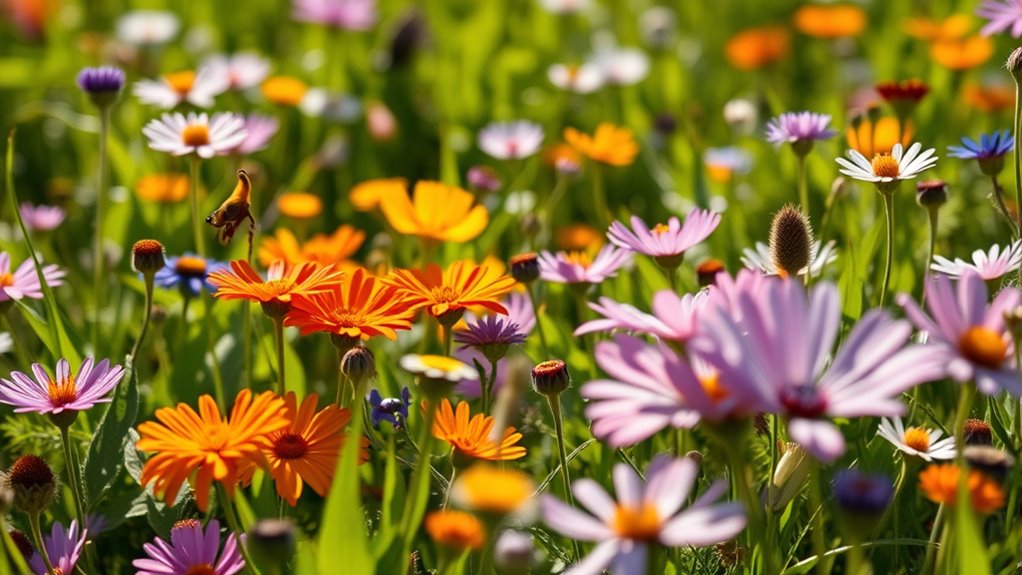
Choosing the right equipment is essential for successful field photography because it allows you to adapt to different conditions and capture high-quality images. For plant identification, a good camera with macro capabilities is crucial for close-up shots of leaves, flowers, and textures. A sturdy, lightweight tripod helps stabilize your shots, especially in uneven terrain. Don’t forget a reliable lens cleaning kit to maintain equipment performance; dirt and dust can degrade image quality. Regular equipment maintenance ensures your gear functions properly and extends its lifespan. Pack extra batteries and memory cards to avoid interruptions during long shoots. Selecting durable, weather-resistant gear is also important, as field conditions can change rapidly. Additionally, understanding photography techniques can significantly improve your results in the field. With the right tools and proper maintenance, you’re prepared to capture clear, detailed plant images in the field.
Mastering Composition and Framing Techniques
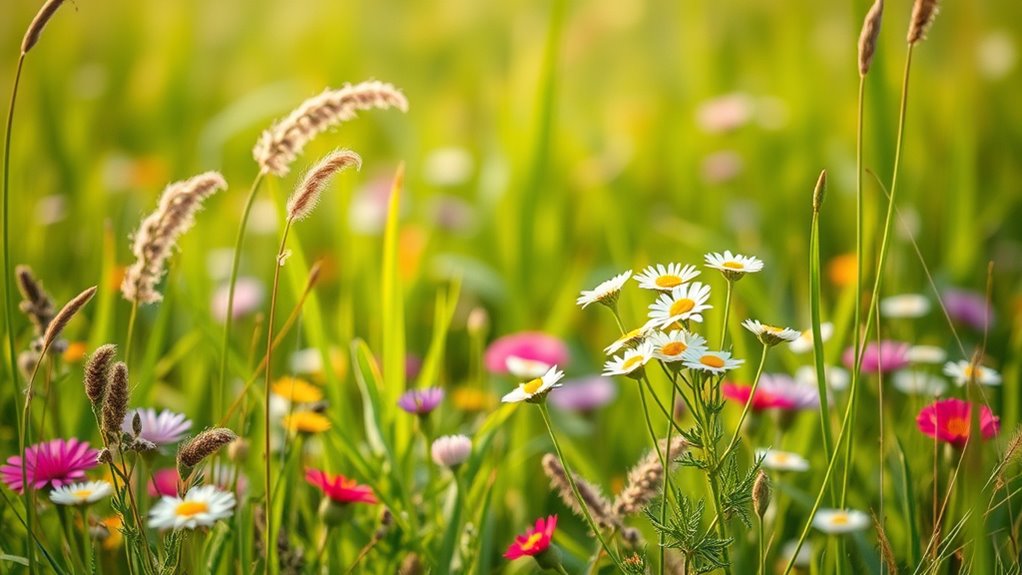
Mastering composition and framing is essential to creating compelling field photographs that draw viewers in. To achieve this, focus on color contrast, which makes your subject stand out against its background. Bright, complementary colors or subtle tonal differences can highlight key plant features. Symmetry balance also plays a crucial role; aligning elements within your frame creates harmony and guides the viewer’s eye naturally. Use the rule of thirds to position your subject off-center, adding visual interest. Pay attention to the background and avoid clutter that distracts from the plant. Experiment with different angles and distances to find the most striking arrangement. Additionally, understanding the importance of visual hierarchy can help prioritize the most important elements in your composition. By thoughtfully controlling composition and framing, you enhance your plant’s visual appeal and improve your chances of accurate identification.
Utilizing Natural Light to Enhance Plant Details
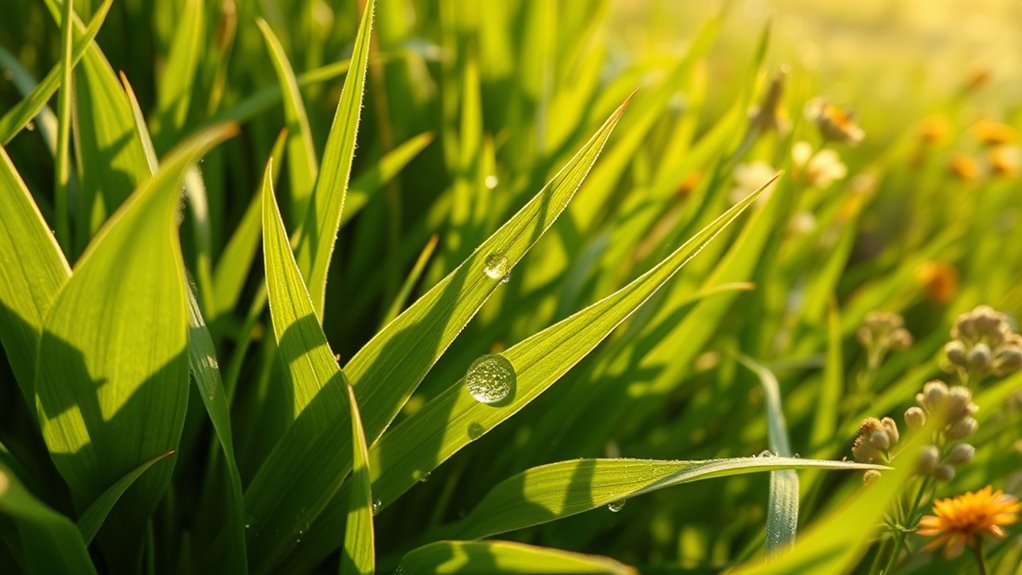
Natural light is one of the most powerful tools for capturing intricate plant details, as it reveals textures, colors,, and patterns more vividly than artificial lighting. To maximize its benefits, consider these tips:
- Use reflected light by positioning yourself to bounce sunlight onto the plant, enhancing subtle details.
- Capture images during the golden hours when diffused sunlight softens shadows and highlights textures without harsh contrasts.
- Avoid direct midday sun, which can cause overexposure and wash out details; instead, seek shaded areas or cloudy days.
- Experiment with angles to utilize reflected light and diffused sunlight, revealing the plant’s intricate patterns and vibrant hues more effectively.
- Incorporate diffused natural light to reduce harsh shadows, creating a more even illumination that highlights fine details.
Focusing Strategies for Sharp and Clear Images
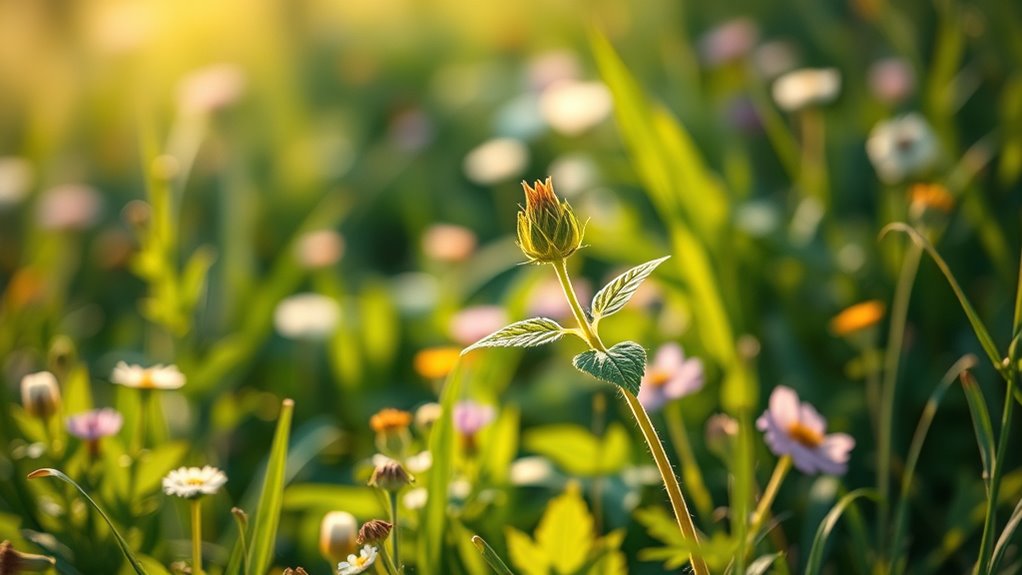
To get sharp, clear images, use focus lock to keep your subject perfectly in focus before recomposing your shot. Adjust your aperture settings to control depth of field, ensuring your main subject stands out. These strategies help you maintain precise focus in busy or changing environments. Additionally, pay attention to headphone compatibility when using audio equipment to ensure clear sound during your photography sessions.
Use Focus Lock
Focus lock is a powerful tool that can help you capture sharp, well-focused images, especially when your subject is moving or lighting conditions are challenging. It allows you to lock onto your subject’s focus point, preventing accidental shifts that can ruin a shot. To use focus lock effectively:
- Focus on your subject, then press the shutter button halfway to lock focus.
- Recompose your shot without releasing the focus lock.
- Keep in mind that the focus lock affects your depth of field, so plan your framing accordingly.
- Practice locking focus on different distances to understand how it impacts sharpness and clarity.
- Understanding your camera’s autofocus system, including focus modes, can further improve your ability to achieve sharp images.
Adjust Aperture Settings
Adjusting your aperture settings is essential for achieving sharp, clear images, especially when controlling depth of field. Your aperture control influences how much of the scene is in focus, helping you highlight the plant details you need. A wider aperture (smaller f-number) creates a shallow depth of field, blurring the background and emphasizing your subject. Conversely, a narrower aperture (larger f-number) increases depth of field, keeping more of the scene in focus. Use this table to decide your aperture setting:
| Desired Effect | Aperture Control | Result |
|---|---|---|
| Focus on a single plant | Small f-number | Blurred background |
| Landscape shot | Large f-number | Everything in focus |
| Close-up detail | Moderate f-number | Sharp foreground and background |
Mastering aperture control helps you capture stunning, focused plant images in the field. Additionally, understanding how filter selection impacts image quality can help you optimize your results.
Capturing Multiple Angles and Close-ups
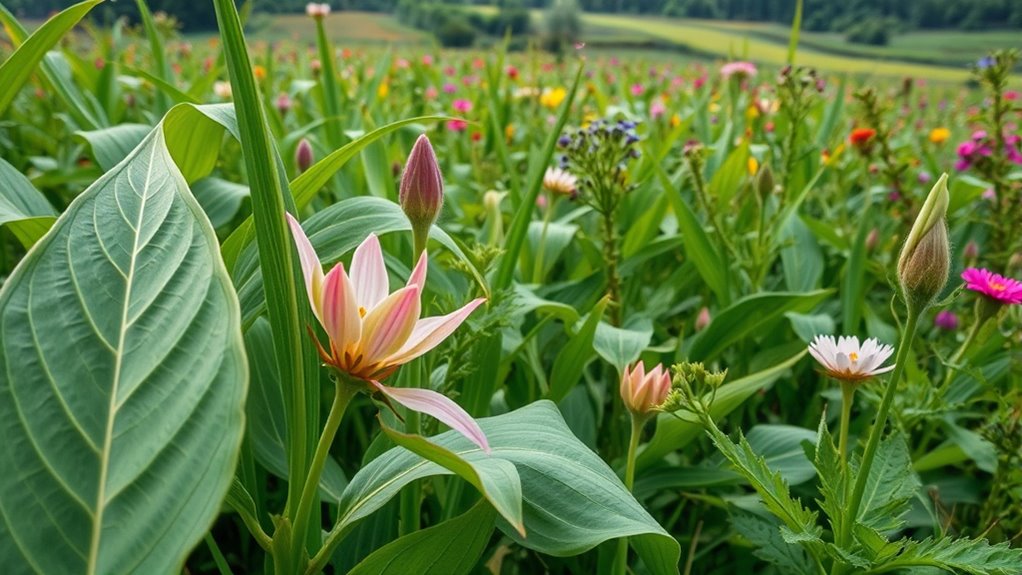
To capture compelling images, try different angles to add variety and highlight different aspects of your subject. Focus on key details to make your close-ups stand out, ensuring they remain sharp and clear. Using macro settings can help you get stunning close-ups that reveal intricate textures and features. Incorporating proper lighting techniques can further enhance the clarity and vibrancy of your plant photographs.
Varying Perspectives Maintain Clarity
Capturing multiple angles and close-ups can substantially enhance the clarity and interest of your photos. By varying your perspective, you improve depth perception and reduce perspective distortion, making plant details clearer. To do this effectively:
- Take shots from different heights and angles to showcase various features.
- Use close-ups to highlight textures and intricate structures.
- Shift your position to avoid perspective distortion, ensuring proportions look natural.
- Incorporate foreground elements for depth, making your images more engaging.
- Experiment with different viewpoints to capture the full beauty and complexity of plants in the field.
This approach helps viewers better understand plant structures and details. Changing perspectives not only sharpens clarity but also adds visual interest, making your photos more informative and appealing. Remember, experimenting with angles is key to capturing the full beauty and complexity of plants in the field.
Focus on Key Details
Focusing on key details through multiple angles and close-ups allows you to reveal the intricate features that often go unnoticed. By capturing different perspectives, you can showcase leaf arrangements, flower structures, and textures essential for accurate plant identification. Consider how plant habitat and weather conditions might influence your shots; a rainy day can highlight water droplets, while bright sunlight reveals color nuances. Use the table below to guide your approach:
| Aspect | Tips |
|---|---|
| Plant Habitat | Observe surroundings to find unique features or growth patterns |
| Weather Conditions | Capture textures and colors under different lighting and moisture levels |
| Angles & Close-ups | Vary perspectives to emphasize details like leaf veins or petal structure |
Additionally, understanding plant health can help you interpret subtle changes in appearance that indicate specific species or conditions. This focused approach ensures your photos provide detailed information, aiding in identification efforts.
Use Macro for Close-ups
Using a macro lens allows you to capture stunning close-up shots that reveal intricate details often hidden to the naked eye. When photographing plants, focus on multiple angles to showcase unique features. For example:
- Get close to a flower petal to highlight its delicate veins and subtle color variations.
- Zoom in on leaf texture to emphasize surface patterns and tiny hairs.
- Experiment with different perspectives to reveal hidden structures, like the underside of a leaf or the stamen inside a flower.
- Use a shallow depth of field to make details stand out sharply against a blurred background.
- Incorporate plant identification techniques into your photography to enhance the accuracy and usefulness of your images.
These techniques help you document plant features essential for identification, making your photos both informative and visually striking. Macro photography discover a new level of plant observation, revealing details often missed at a glance.
Managing Environmental Challenges in the Field
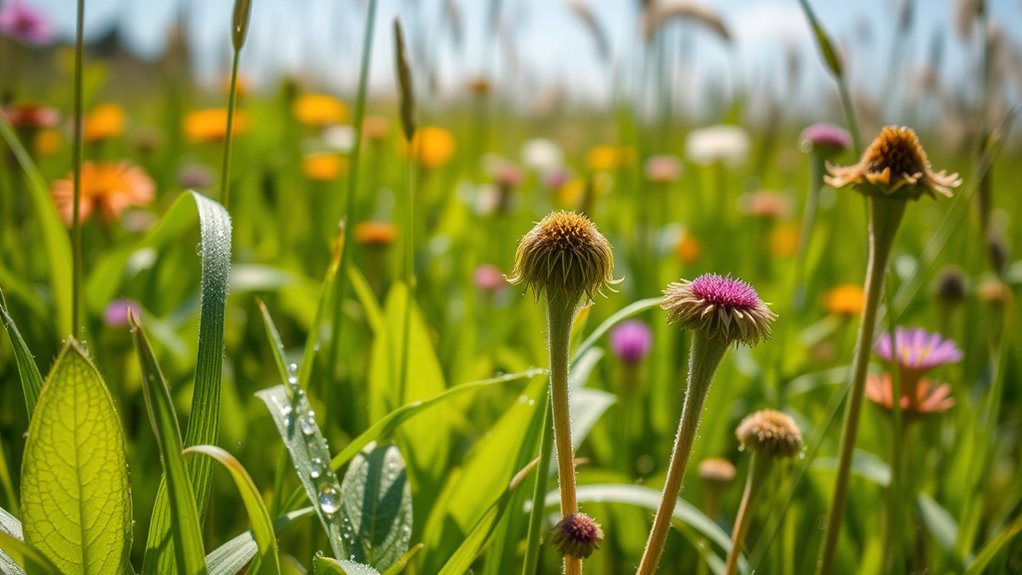
When working outdoors, environmental challenges like unpredictable weather, harsh lighting, and shifting terrain can disrupt your photography plans. To manage these, prepare for wind resistance by securing your equipment with straps or weights. Be mindful of wildlife disturbance; avoid sudden movements or loud noises that scare animals away. Adjust your position to minimize harsh shadows and overexposure from the sun. Use a lens hood to reduce glare and protect your gear. Keep an eye on changing terrain to prevent slips or falls. Here’s a quick overview:
| Challenge | Solution |
|---|---|
| Wind resistance | Secure equipment, use wind-resistant gear |
| Wildlife disturbance | Maintain distance, move quietly |
| Harsh lighting | Use diffusers or seek shade |
| Shifting terrain | Wear sturdy shoes, plan your route |
Frequently Asked Questions
How Can I Identify Rare or Endangered Plant Species in the Field?
To identify rare or endangered plant species in the field, start by observing unique features like leaf shape and flower structure. Use ecological habitat mapping to narrow down your options, focusing on areas where these plants typically grow. For more precise identification, consider collecting samples for plant DNA analysis later. This approach helps confirm species, especially when visual cues are ambiguous, ensuring you accurately recognize rare or endangered plants in their natural environment.
What Are the Best Practices for Photographing Plants in Difficult Weather Conditions?
When tackling tough weather, think of your camera as your shield against nature’s chaos. To capture sharp, clear plant images, prioritize camera stability—use a tripod or sturdy surface. Pay attention to plant moisture; wet leaves can reflect light and create glare, so gently wipe or adjust angles. Weather-resistant gear helps too. Embrace the challenge, and your photos will reveal the resilience and beauty of plants even in harsh conditions.
How Do I Prevent Damaging Delicate Plants While Taking Close-Up Shots?
To prevent damaging delicate plants during close-up shots, handle them gently using proper plant handling techniques. Use your camera accessories like a macro lens with a steady hand or tripod to avoid unnecessary pressure. Be mindful of stems and leaves, supporting fragile parts without bending or breaking them. Always prioritize the plant’s health, taking your photos swiftly yet carefully, so you leave the plant unharmed in its natural environment.
What Techniques Help in Capturing Plants During Low-Light or Dusk Conditions?
Did you know that night photography can capture stunning plant details in low light? To succeed during dusk, use a sturdy tripod to keep your camera steady, reducing blur. Experiment with slow shutter speeds to let in more light, and consider using a remote shutter or timer to avoid camera shake. These tripod techniques help you beautifully capture plants, even in challenging low-light conditions, revealing their intricate structures and textures.
How Can I Effectively Document Plant Variations Across Different Seasons?
To effectively document plant variations across different seasons, focus on capturing seasonal growth and plant phenology. Visit your sites regularly to record changes over time, noting flowering, fruiting, and leaf color shifts. Use consistent angles and settings to compare images easily. Document the timing of key phenological events to understand seasonal patterns, helping you track how plants adapt and evolve throughout the year.
Conclusion
By choosing the right equipment, mastering composition, and utilizing natural light, you set the foundation for stunning plant photos. Focus sharply, capture from multiple angles, and manage environmental challenges with confidence. Embrace patience and persistence, adapt to your surroundings, and celebrate every detail you uncover. With these tips, you’ll not only photograph plants more effectively but also deepen your connection with the natural world, turning each field session into a rewarding journey of discovery and growth.

